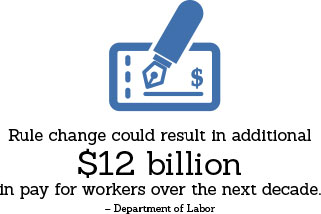UPDATE: On August 31st, a federal judge made a final ruling on the proposed overtime rule changes made by President Obama in 2016. The judge declared the overtime rule invalid. As a result, employers do not need to make any changes; the existing overtime regulations that include the $23,660 exempt salary threshold will still apply. However, changes in the future are still expected, but what those new regulations will entail remain to be seen. Brush up on the current DOL overtime regulations here. For more information on how to determine employee exemption status, click here.
NEW DOL OVERTIME CHANGES MAY AFFECT YOUR BUSINESS
The Department of Labor last updated the FLSA overtime pay rules in 2004. The newest changes (as of May 2016) increase the threshold to $47,476 annually, or $913 per week. The Department of Labor will increase the salary threshold every three years, with an expected increase to more than $51,000 on January 1, 2020. Employers must comply with the new regulations by December 1, 2016.

The change could complicate the exemption process for employers because it increases the number of employees that are considered non-exempt from overtime pay. If you have questions regarding your employees, check the FLSA duties test, which will provide you with the exemption status of your employees. Please be advised that the DOL is evaluating whether, or not, to revise the duties test to fit the new rules.
BEST PRACTICES FOR A SMOOTH TRANSITION WITH NEW OVERTIME RULE
TIME KEEPING SYSTEM
If you do not track time already, then you should invest in a time and attendance system and implement strict policies regarding employee use of time keeping systems. Use the time and attendance system to keep accurate records of hours worked per employee, and monitor it closely so you can effectively manage employee hours.

WHETHER TO RAISE SALARIES OR RESTRUCTURE WORK HOURS OR DUTIES.
Don’t be afraid of paying a salary, but just keep in mind that salary and hourly aren’t the only measurements that will change overtime exemption. Manage your salaried employees and make sure you are selective on who is raised to the new $47,476 overtime exemption threshold.
MANAGING OFF-SITE AND FLEXIBLE WORK SCHEDULE EMPLOYEES.
If you offer telecommuting, have off-site employees, or have any other form of flexible work schedules, then the new overtime changes could be a more challenging obstacle to manage. Developing protocols that govern after hours work communication can enforce limitations on the work day, and closely monitoring the weekly hours of your employees can impact your wages.
AUDIT EMPLOYEES TO IDENTIFY WHICH WILL BE AFFECTED BY THE NEW RULES.

The worst thing an employer can do is be unprepared for the new overtime rule changes. The risks and fines are extremely high for employers that procrastinate on this DOL enforced regulation. Don’t risk being unprepared. Instead, find some time now to talk to payroll and human resource experts that can help you analyze your employee classifications:
- How many hours are your employees working now?
- What is the hourly and annual wage of your employees?
- What would the anticipated overtime pay be for affected employees?
- How can you cut back employee hours so they do not qualify